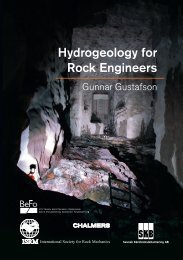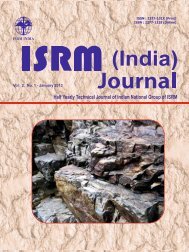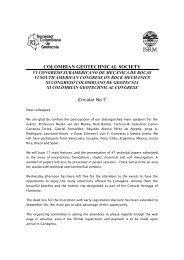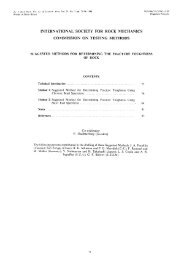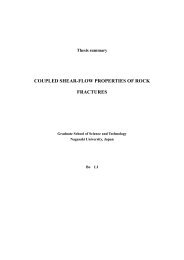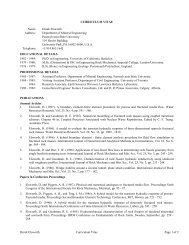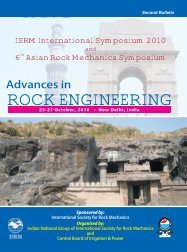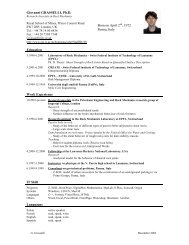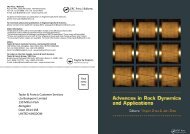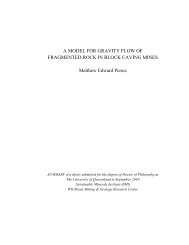ISSN : 2277-1328 (Online) - ISRM
ISSN : 2277-1328 (Online) - ISRM
ISSN : 2277-1328 (Online) - ISRM
You also want an ePaper? Increase the reach of your titles
YUMPU automatically turns print PDFs into web optimized ePapers that Google loves.
Study of Wellbore Stresses and Stability based on a Hollow Cylinder Model<br />
11<br />
...(6)<br />
Note that S o<br />
can be linked to C o<br />
and ϕ through S o<br />
= C o<br />
/2q 1/<br />
2<br />
where q = [(μ 2 +1) 1/2 + μ] 2 = tan 2 (π/4 + ϕ/2].<br />
Fig. 1 : Comparison of different rock failure criteria<br />
in the π-plane.<br />
Mohr proposed that when shear failure takes place across<br />
a plane, the normal stress σ n<br />
and the shear stress τ across<br />
that plane are related by<br />
|τ| = S o<br />
+ μs n<br />
...(1)<br />
where S o<br />
= cohesion and μ = the coefficient of internal<br />
friction of the material which is related to the angle of<br />
internal friction ϕ of that material by μ = tanϕ. Since the<br />
sign of τ only affects the sliding direction, only the<br />
magnitude of τ matters. Presented in terms of principal<br />
stresses, the Mohr-Coulomb criterion is:<br />
σ 1<br />
= C o<br />
+ σ 3<br />
tan 2 β ...(2)<br />
where σ 1<br />
= the major principal effective stress at failure,<br />
σ 3<br />
= the least principal effective stress at failure, C o<br />
= the<br />
uniaxial compressive strength, and β gives the orientation<br />
of the failure plane and is related to internal friction angle<br />
ϕ as β = π/4 + ϕ/2. In some formulations tan 2 β is replaced<br />
by q, where q = [(μ 2 +1) 1/2 + μ] 2 .<br />
The Lade criterion [9] is a three-dimensional failure criterion.<br />
Originally proposed for cohessionless sands, the criterion<br />
was then adopted for analyzing rocks with finite values of<br />
cohesion and tensile strength [10] and such a formulation<br />
was later linked [11] with standard rock mechanics<br />
parameters such as ϕ and S o<br />
to obtain:<br />
where I 1<br />
’ and I 3<br />
’ are stress invariants<br />
...(3)<br />
I 1<br />
’ = [(σ 1<br />
+ S – P p<br />
)+(σ 2<br />
+ S – P p<br />
) +(σ 3<br />
+ S – P p<br />
) ...(4)<br />
I 3<br />
’ = [(σ 1<br />
+ S – P p<br />
)(σ 2<br />
+ S – P p<br />
) (σ 3<br />
+ S – P p<br />
) ...(5)<br />
where S and η are material constants, and P p<br />
is the pore<br />
pressure. The parameter S is related to the cohesion of<br />
the rock, while η represents the internal friction. These<br />
parameters can be derived directly from the Mohr-Coulomb<br />
cohesion S o<br />
and internal friction angle ϕ by<br />
The typical behaviour of the Modified Lade criterion is<br />
shown in Figs 1 and 2. In principal stress space criterion [3]<br />
has the form of a convex, triangularly shaped cone. The<br />
parameter η determines the shape of the cross-section in<br />
the π-plane: increasing values of h correspond to the crosssectional<br />
shape changes from circular to triangular with<br />
smoothly rounded edges, Fig. 1. When plotted in σ 1<br />
- σ 2<br />
space, the criterion first predicts a strengthening effect<br />
with increasing intermediate principal stress s 2<br />
followed<br />
by a slight reduction in strength once s 2<br />
becomes ‘‘too<br />
high’’, Fig. 2. Thus, the Modified Lade criterion seems to<br />
provide a good alternative to the Mohr-Coulomb criterion.<br />
Fig. 2 : Behaviour of different failure criteria in σ 1<br />
-σ 2<br />
space<br />
for different values of confining stress σ 3<br />
.<br />
The extended von Mises yield criterion, or the Drucker-<br />
Prager criterion, was originally developed for soil<br />
mechanics. The yield surface of that criterion in principal<br />
stress space is a right circular cone equally inclined to<br />
the principal-stress axes, Fig. 1. The intersection of the<br />
p-plane with this surface is a circle and the Drucker-Prager<br />
yield function has the form:<br />
1/2<br />
J 2<br />
= k + α 1<br />
J 1<br />
...(7)<br />
where<br />
J 1<br />
= (σ 1<br />
+σ 2<br />
+σ 3<br />
)/3 ...(8)<br />
J 2<br />
= [(σ 1<br />
-σ 2<br />
)+(σ 2<br />
-σ 3<br />
) +(σ 1<br />
-σ 3<br />
) 2 ]/6 ...(9)<br />
The material parameters α 1<br />
and k can be determined from<br />
the slope and the intercept of the failure envelope plotted<br />
1/2<br />
in the J 1<br />
- J 2<br />
space: α 1<br />
is related to the internal friction of<br />
the material and k is related to its cohesion. In this way,<br />
the Drucker-Prager criterion can be compared to the Mohr-<br />
Coulomb criterion.<br />
The Drucker-Prager criterion can be further divided into an<br />
outer bound criterion (or Circumscribed Drucker-Prager) and<br />
an inner bound criterion (or Inscribed Drucker-Prager). These<br />
Volume 1 No. 2 July 2012




